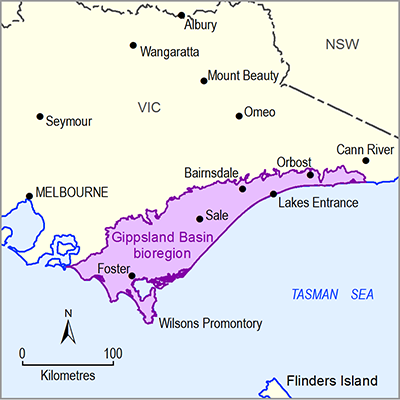Late Jurassic to Early Cretaceous
In the Late Jurassic to Early Cretaceous, a series of east oriented grabens developed across the southern margin of Australia, during the initial stages of rifting between Australia and Antarctica (Duddy, 2003; Webb et al., 2011). Subsidence, accommodated by crustal extension, resulted in the deposition of the Strzelecki Group in the Gippsland Basin. During the middle Cretaceous, the rift between Australia and Antarctica moved to the south of Tasmania as the Southern Ocean began opening (Webb et al., 2011). The eastern part of the original graben remained active as the Gippsland Basin (Duddy, 2003; Webb et al., 2011). A phase of compression near the beginning of the Late Cretaceous (about 96 Ma) was associated with the breakup of Australia and Antarctica (Chiupka, 1996). This resulted in development of elevated regions along the basin margin referred to as the Lakes Entrance and Southern platforms. Extensive erosion of Strzelecki Group rocks occurred following this uplift (Chiupka, 1996) producing a major unconformity in the Gippsland Basin known as the Otway Unconformity (Duddy, 2003). Uplift during this time is thought to have been accompanied by a major thermal event that strongly influenced the rank of the Strzelecki Group coals (Holdgate, 2003).
Late Cretaceous to Late Eocene
During the Late Cretaceous, the central part of the basin subsided rapidly, resulting in the deposition of the Latrobe Group in the now offshore part of the basin.
Early normal displacement along the Rosedale and Darriman faults (regional east-west trending intrabasinal elements) occurred during a second phase of rifting near the middle of the Late Cretaceous (80 Ma). This was associated with the Australia/Lord Howe Rise separation and opening of the Tasman Sea (Duddy, 2003; Goldie Divko et al., 2009) and led to development of the Northern and Southern Strzelecki Terraces (Goldie Divko et al., 2009).
Lower rates of subsidence continued across the onshore basin from the end of the Cretaceous to the late Eocene (65 to 35 Ma) accommodating further deposition of Latrobe Group sediments.
Late Eocene to Late Miocene
A major basin-wide compressional event is believed to have occurred during the late Eocene to early Miocene that caused many of the structural features evident today and terminated deposition of the Latrobe Group. Compressional uplift during this time is evident in the present landscape as the uplifted fault blocks of the Lower Cretaceous (Strzelecki Group) South Gippsland highlands including the Balook, Gelliondale, Tarwin, Narracan and Warragul blocks that form the westerly basin limits (Holdgate and Gallagher, 2003). All major fold structures at the top of the Latrobe Group, which became hosts for the large offshore oil and gas accumulations, relate to late Eocene to Miocene tectonism (Geoscience Australia, 2014).
During the Cenozoic, the Gippsland Basin underwent a gradual transition from essentially non-marine to more marine as a result of the opening of the Southern Ocean during the Late Cretaceous (Holdgate and Gallagher 2003). During the Neogene (Miocene-Pliocene), the Gippsland Basin was predominantly marine with deposition of limestones and marls of the Seaspray Group. However in some areas, non-marine sediments accumulated behind transgressive barrier sands (Balook Formation) along a shifting shoreline (Holdgate et al., 1988). This sedimentation resulted in the deposition of the extensive coals of the Latrobe Valley Group.
During the middle to late Miocene-early Pliocene (10 to 5 Ma), north-west oriented compression associated with the Kosciuszko Uplift created the Balook Block (Webb et al., 2011). Miocene limestones thin onto highs such as the Baragwanath Anticline, indicating slow uplift contemporaneous with deposition before the Pliocene (Holdgate and Gallagher, 2003). Folding, uplift and erosion of the Latrobe Valley Group and Alberton Coal Measures is noted during this time, influencing the accessibility of brown coal resources in the basin (Holdgate et al., 2000).
Pliocene to recent
Tectonism continued to affect the basin during the late Pliocene to Pleistocene, as documented by localised uplift. A late Pliocene unconformity that correlates to the period of compression, folding, uplift and erosion is known as the Kosciuszko Uplift (Holdgate et al., 2007).
Much of south-eastern Australia is now currently under a north-north-west to south-south-east compression regime related to northward movement of the Australian Plate. Most of the onshore Gippsland Basin folds trend north-north-east, approximately at right angles to this compressional direction (Holdgate, 2003). Ongoing tectonic activity continues in the basin as relatively minor earthquakes along and around major basin bounding faults (Geoscience Australia, 2014).
In the now offshore part of the basin, the youngest carbonate facies of the Gippsland Basin date to about 0.2 Ma (Middle Pleistocene). Onshore, marine regression during the late Pliocene to early Pleistocene resulted in terrestrial siliciclastic sedimentation in a series of outwash fans, river gravels and alluvium (Cupper et al., 2003). During the early to middle Pleistocene siliciclastic sediments were deposited in fluvial-channel and estuarine environments by rivers flowing to the sea during glacial lowstands. Of particular significance are the paleochannels of the present-day Snowy, Nicholson/Tambo, Mitchell, Avon/Perry and Thompson/Macalister/Merrimans rivers, and Ironstone Creek, where thick accumulations of sand, gravel, clay and silts have deposited (Cupper et al., 2003). Offshore, paleochannels have also been identified in Pleistocene sediments using magnetic imagery (Bernecker and Partridge, 2005).
A series of sandy barrier ridges formed along the Pliocene to Pleistocene coastline of the Gippsland Basin. These barrier systems underlie the modern Gippsland Lakes and Ninety Mile Beach barrier system and extend offshore (Bernecker and Partridge, 2005). These barrier systems are now buried by more recent sediments across the basin. Erosion of these sediments onshore is evident in the area immediately south of Lakes Entrance and north-east of the Mitchell River (Cupper et al., 2003). The present-day Gippsland Lakes system formed in the late Pleistocene to Holocene behind sand barriers and dunes of the Ninety Mile Beach (Holdgate et al., 2003).

